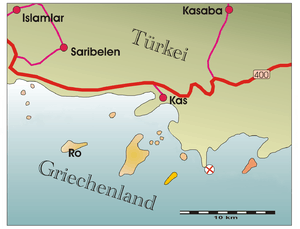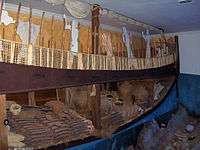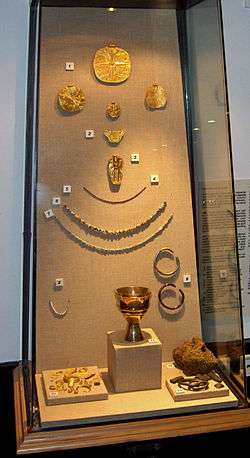Uluburun shipwreck
The Uluburun Shipwreck is a Late Bronze Age shipwreck dated to the late 14th century BC,[1] discovered close to the east shore of Uluburun (Grand Cape), and about 6 miles (9.7 km) miles southeast of Kaş, in south-western Turkey.[2] The shipwreck was discovered in the summer of 1982 by Mehmed Çakir, a local sponge diver from Yalıkavak, a village near Bodrum.
Uluburun is Turkish for "Grand Cape" | |
 Wooden model of the ship's reconstruction | |
 Site of the wreck 50 m (160 ft) off the eastern shore of Uluburun, and 6 mi (9.7 km) to the southeast of Kaş, Turkey | |
| Location | Uneven slope of the headland's shelf, 44 m (144 ft) to 52 m (171 ft) deep, with artifacts down to 61 m (200 ft) |
|---|---|
| Region | Bay of Antalya, off the Turquoise Coast. |
| Coordinates | 36°7′43″N 29°41′9″E |
| Type | Site of a sunken ship |
| Length | About 10 m (33 ft) N-S, horizontal plot plan |
| Width | About 18 m (59 ft) E-W, horizontal plot-plan |
| Area | 180 m2 (1,900 sq ft), horizontal plot-plan |
| Height | Depth differential is 8 m (26 ft) vertical, with scattered artifacts, 17 m (56 ft) |
| History | |
| Builder | Unknown. The cargo was probably Mycenaean, deduced from the major type of ingot |
| Material | Wooden, single-mast, two-prow (stem, stern) sailing ship with one steering oar on a side |
| Founded | Built after 1305 BC; date obtained by dendrochronological dating |
| Abandoned | Sank late 14th century BC |
| Periods | Late Bronze Age |
| Cultures | Mycenaean, Cypriote, judging by the pottery |
| Associated with | Crew of the merchant vessel |
| Events | Collision with the headland, perhaps wind-driven |
| Site notes | |
| Excavation dates | Excavational dives directed by George Bass in 1984, and Cemal Pulak in 1985–1994 |
| Archaeologists | George F. Bass, Cemal Pulak |
| Condition | Conservation, sampling and study are ongoing |
| Ownership | Republic of Turkey |
| Management | Institute of Nautical Archaeology, an international organization |
| Public access | Objects may be viewed in the exhibit at the Bodrum Museum of Underwater Archaeology |
| Website | "Uluburun, Turkey". |
Eleven consecutive campaigns of three to four months' duration took place from 1984 to 1994 totaling 22,413 dives, revealing one of the most spectacular Late Bronze Age assemblages to have emerged from the Mediterranean Sea.[3]
Discovery
The shipwreck site was discovered in the summer of 1982 due to Mehmet Çakir's sketching of “the metal biscuits with ears” recognized as oxhide ingots. Turkish sponge divers were often consulted by the Institute of Nautical Archaeology's (INA) survey team on how to identify ancient wrecks while diving for sponges.[4] Çakir's findings urged Oğuz Alpözen, Director of the Bodrum Museum of Underwater Archaeology, to send out an inspection team of the Museum and INA archaeologists to locate the wreck site. The inspection team was able to locate several amounts of copper ingots just 50 metres from the shore of Uluburun.[5]
Apparent route
With the evidence provided from the cargo on the ship it can be assumed that the ship set sail from either a Cypriot or Syro-Palestinian port. The Uluburun ship was undoubtedly sailing to the region west of Cyprus, but her ultimate destination can be concluded only from the distribution of objects matching the types carried on board.[6] It has been proposed that ship's destination was a port somewhere in the Aegean Sea.[7] Rhodes, at the time an important redistribution centre for the Aegean, has been suggested as a possible destination.[8] According to the excavators of the shipwreck, the probable final destination of the ship was one of the Mycenaean palaces, in mainland Greece.[9]
Dating
Peter Kuniholm of Cornell University was assigned the task of dendrochronological dating in order to obtain an absolute date for the ship. The results date the wood at 1305 BC, but given that no bark has survived it is impossible to determine an exact date and it can be assumed that the ship sank sometime after that date.[10] Based on ceramic evidence, it appears that the Uluburun sank toward the end of the Amarna period, but could not have sunk before the time of Nefertiti due to the unique gold scarab engraved with her name found aboard the ship.[11] For now, a conclusion that the ship sank at the end of the 14th century BC is accepted.
The origins of the objects aboard the ship range geographically from northern Europe to Africa, as far west as Sicily and Sardinia, and as far east as Mesopotamia. They appear to be the products of nine or ten cultures.[8] These proveniences indicate that the Late Bronze Age Aegean was the medium of an international trade perhaps based on royal gift-giving in the Near East.[12]
According to a reconstruction by various scholars, the Uluburun shipwreck illustrates a thriving commercial sea network of the Late Bronze Age Mediterranean. In this case, a huge mixed cargo of luxury items, royal gifts and raw materials. According to the findings, it has been suggested that Mycenaean officials were also aboard accompanying the gifts.[13] A small (9.5 x 6.2 cm), folding boxwood writing-tablet was found with partially extant ivory hinges. It likely would have had wax writing surfaces.[14]
The vessel

The distribution of the wreckage and the scattered cargo indicates that the ship was between 15 and 16 metres (49 and 52 ft) long. It was constructed by the shell-first method, with mortise-and-tenon joints similar to those of the Graeco-Roman ships of later centuries.[15]
Even though there has been a detailed examination of Uluburun's hull, there is no evidence of framing. The keel appears to be rudimentary, perhaps more of a keel-plank than a keel in the traditional sense. The ship was built with planks and keel of Lebanese cedar and oak tenons.[16] Lebanese cedar is indigenous to the mountains of Lebanon, southern Turkey, and central Cyprus.[17] The ship carried 24 stone anchors. The stone is of a type almost completely unknown in the Aegean, but is often built into the temples of Syria-Palestine and on Cyprus. Brushwood and sticks served as dunnage to help protect the ship's planks from the metal ingots and other heavy cargo.[11]
Cargo
- This is a list of the cargo as described by Pulak (1998).
The Uluburun ship's cargo consisted mostly of raw materials that were trade items, which before the ship's discovery were known primarily from ancient texts or Egyptian tomb paintings. The cargo matches many of the royal gifts listed in the Amarna letters found at El-Amarna, Egypt.
- Copper and tin ingots
- Raw copper cargo totaling ten tons, consisting of a total of 354 ingots of the oxhide (rectangular with handholds extending from each corner) type.
- Out of the total amount of ingots at least 31 unique two-handled ingots were identified that were most likely shaped this way to assist the process of loading ingots onto specially designed saddles or harnesses for ease of transport over long distances by pack animals.
- 121 copper bun and oval ingots.
- The oxhide ingots were originally stowed in 4 distinct rows across the ship's hold, which either slipped down the slope after the ship sank or shifted as the hull settled under the weight of the cargo.
- Approximately one ton of tin (when alloyed with the copper would make about 11 tons of bronze).
- Tin ingots were oxhide and bun shaped.
- Canaanite jars and Pistacia resin
- At least 149 Canaanite jars (widely found in Greece, Cyprus, Syria-Palestine, and Egypt).
- Jars are categorized as the northern type and were most likely made somewhere in the northern part of modern-day Israel.
- One jar filled with glass beads, many filled with olives, but the majority contained a substance known as Pistacia (terebinth) resin, an ancient type of turpentine.
- Recent clay fabric analyses of Canaanite jar sherds from the 18th-Dynasty site of Tell el-Amarna have produced a specific clay fabric designation, and it is seemingly the same as that from the Uluburun shipwreck, of a type that is exclusively associated in Amarna with transporting Pistacia resin.
- Glass ingots
- Approximately 175 glass ingots of cobalt blue, turquoise, and lavender were found (earliest intact glass ingots known).
- Chemical composition of cobalt blue glass ingots matches those of contemporary Egyptian core-formed vessels and Mycenaean pendant beads, which suggests a common source.

1 gold disk-shaped pendant 2. gold falcon pendant 3. gold goddess pendant 4. faience beads 5. rock crystal beads 6. agate beads 7. faience beads 8. ostrich eggshell beads 9. silver bracelets 10. gold scrap 11. gold chalice 12. accreted mass of tiny faience beads 13. silver scrap
- Miscellaneous cargo
- Logs of blackwood from Africa (referred to as ebony by the Egyptians)
- Ivory in the form of whole and partial hippopotamus and elephant tusks
- More than a dozen hippopotamus teeth
- Tortoise carapaces (upper shells)
- Murex opercula (possible ingredient for incense)
- Ostrich eggshells
- Cypriot pottery
- Cypriot oil lamps
- Bronze and copper vessels (four faience drinking cups shaped as rams’ heads and one shaped as a woman's head)
- Two duck-shaped ivory cosmetics boxes
- Ivory cosmetics or unguent spoon
- Trumpet
- More than two dozen sea-shell rings
- Beads of amber (Baltic origin)
- Agate
- Carnelian
- Quartz
- Gold
- Faience
- Glass
- Jewelry, gold, and silver
- Collection of usable and scrap gold and silver Canaanite jewelry
- Among the 37 gold pieces are: pectorals, medallions, pendants, beads, a small ring ingot, and an assortment of fragments
- Biconical chalice (largest gold object from wreck)
- Egyptian objects of gold, electrum, silver, and steatite (soap stone)
- Gold scarab inscribed with the name of Nefertiti
- Bronze female figurine (head, neck, hands, and feet covered in sheet gold)
- Weapons and tools
- Arrowheads
- Spearheads
- Maces
- Daggers
- Lugged shaft-hole axe
- A single armor scale of Near Eastern type
- Four swords (Canaanite, Mycenaean, and Italian(?) types)
- Large number of tools: sickles, awls, drill bits, a saw, a pair of tongs, chisels, axes, a ploughshare, whetstones, and adzes
- Pan-balance weights
- 19 zoomorphic weights (Uluburun weight assemblage is one of the largest and most complete groups of contemporaneous Late Bronze Age weights)
- 120 geometric-shaped weights
- Edibles
- Almonds
- Pine nuts
- Figs
- Olives
- Grapes
- Safflower
- Black cumin
- Sumac
- Coriander
- Whole pomegranates
- A few grains of charred wheat and barley
Excavation
The Institute of Nautical Archaeology (INA) began excavating in July 1984 under the direction of its founder, George F. Bass, and was then turned over to INA's Vice President for Turkey, Cemal Pulak, who directed the excavation from 1985 to 1994.[18] The wreck lay between 44 and 52 meters deep on a steep, rocky slope riddled with sand pockets.[19] Half of the staff members who aided in the excavation lived in a camp built into the southeastern face of the promontory, which the ship most likely hit, while the other half lived aboard the Virazon, INA's research vessel at the time. The excavation site utilized an underwater telephone booth and air-lifts. The mapping of the site was done by triangulation. Meter tapes and metal squares were used as an orientation aid for excavators.[20] Since the completion of the excavation in September 1994, all efforts have been concentrated on full-time conservation, study, and sampling for analysis in the conservation laboratory of the Bodrum Museum of Underwater Archaeology in Turkey.
References
- Pulak, 2005 p. 34
- Pulak, 1998 p. 188
- Pulak, 1998 p. 188.
- Bass, 1986 p. 269
- Bass, 1986 pp. 269–270.
- Pulak, 1988 p. 36
- Richard, Suzanne (2003). Near Eastern Archaeology: A Reader. Eisenbrauns. p. 136. ISBN 978-1575060835.
- Pulak, 2005 p. 47
- Tartaron, Thomas (2013). Maritime Networks in the Mycenaean World. Cambridge University Press. p. 26. ISBN 978-1107002982.
- Pulak, 1998 p. 214
- Pulak, 2005 p. 46
- Pulak, 1998 p. 220
- Demand, Nancy H. (2011). The Mediterranean Context of Early Greek History. John Wiley & Sons. ISBN 978-1444342345.
- Payton, Robert (2013). "The Ulu Burun Writing-Board Set". Anatolian Studies. 41: 99–106. doi:10.2307/3642932. JSTOR 3642932.
- Pulak, 1998 p. 210.
- Pulak, 1998 p. 213
- Pulak, 2005 p. 43
- Pulak, 2005 p. 35
- Pulak, 1998 p. 189
- Bass, 1986 p. 272
Bibliography
- Bass, George F (1986). "A Bronze Age Shipwreck at Ulu Burun (Kas): 1984 Campaign". American Journal of Archaeology. 90 (3): 269–296. doi:10.2307/505687. JSTOR 505687.
- Pulak, Cemal. "Discovering a Royal Ship from the Age of King Tut: Uluburun, Turkey". In Beneath the Seven Seas, edited by George F. Bass, 34–47. New York, Thames & Hudson Inc., 2005.
- Pulak, Cemal (1988). "The Bronze Age Shipwreck at Ulu Burun, Turkey: 1985 Campaign". American Journal of Archaeology. 92 (1): 1–37. doi:10.2307/505868. JSTOR 505868.
- Pulak, Cemal (1998). "The Uluburun Shipwreck: An Overview". The International Journal of Nautical Archaeology. 27 (3): 188–224. doi:10.1111/j.1095-9270.1998.tb00803.x.
Further reading
- Bass, George F. (December 1987). "Oldest Known Shipwreck Reveals Splendors of the Bronze Age". National Geographic. Vol. 172 no. 6. pp. 692–733. ISSN 0027-9358. OCLC 643483454.
- Bass, George F.; et al. (1989). "The Bronze Age Shipwreck at Ulu Burun: 1986 Campaign". American Journal of Archaeology. 93 (1): 1–29. doi:10.2307/505396. JSTOR 505396.
- Fawcett, N.; Zietsman, J.C. (2001). "Uluburun - the discovery and excavation of the world's oldest known shipwreck". Akroterion. 46: 5–20. doi:10.7445/46-0-116.
- Mumford, Gregory D. "Mediterranean Area". The Oxford Encyclopedia of Ancient Egypt. Ed. Donald B. Redford. Oxford University Press, Inc. 2001, 2005.
- Nicholson, Paul T.; Jackson, Caroline M.; Trott, Katherine M. (1997). "The Ulu Burun Glass Ingots, Cylindrical Vessels and Egyptian Glass". Journal of Egyptian Archaeology. 83: 143–153. doi:10.2307/3822462. JSTOR 3822462.
- Payton, Robert (1991). "The Ulu Burun Writing-Board Set". Anatolian Studies. 41: 99–106. doi:10.2307/3642932. JSTOR 3642932.
- Ward, Cheryl (2003). "Pomegranates in Eastern Mediterranean Contexts during the Late Bronze Age". World Archaeology. 34 (3): 529–541. CiteSeerX 10.1.1.467.11. doi:10.1080/0043824021000026495.
External links
| Wikimedia Commons has media related to Uluburun shipwreck. |
- Continuing work by the Institute of Nautical Archaeology, including Dendrochronological Dating of the Uluburun Ship
- Ancient Greece Declassified Podcast Episode 2: Bronze Age Apocalypse 1177 BC – Episode discusses Uluburun shipwreck.